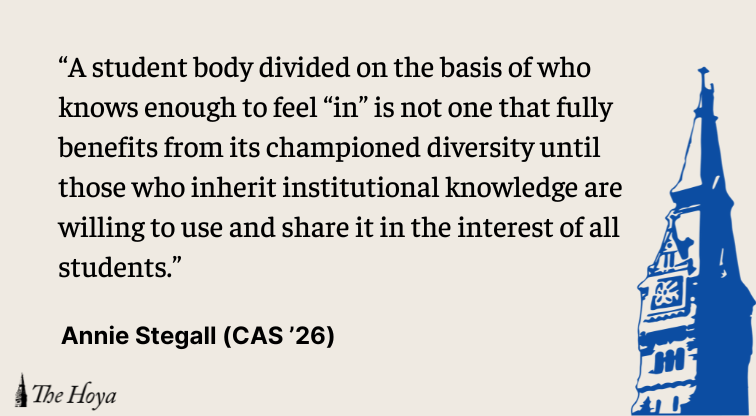“But you’ve moved up for them, why would you still wear that hat?”
I finally understood. The middle-aged man in front of me, whose coffee order I was meant to be taking, was not questioning my Auburn University hat because it was college gameday and he was cheering for a rival team.
“I get it,” he laughed to himself, “I moved up from my family too. Parents went to FSU. Leave that shit behind, you’re here now!”
I stumbled through my defense of Auburn — my love for the school, how jealous I am of their football team and spirit, my respect for my parents and their intellect — and mumbled War Eagle (Auburn’s signature cheer) after writing his order on a cup.
In his assumption that we shared a feeling of superiority in “moving up” to Georgetown, this man articulated the atmosphere of arrogance that circles this school. It reaches beyond school pride and intentionally keeps the notoriously complex social scene at Georgetown largely inaccessible to those without legacy status who lack not only an admissions advantage, but the generational knowledge to navigate intense applications, unconventional interviews, and mysterious social groups.
Diversity in college admissions is an ongoing discussion, one that resurfaced with the end of affirmative action in September of 2023. Asher Maxwell (CAS ’26), Sebastian Cardena (CAS ’26) and Ethan Henshaw (CAS ’26) wrote a compelling Viewpoint for the Hoya that interrogated the demographics of Georgetown’s student body and called for an end to legacy admissions.
“There are more legacy students than Black or Latinx students in Georgetown’s undergraduate population… legacy students were twice as likely to be admitted compared to non-legacy students,” they wrote.
Arguments for legacy admission are generally twofold: universities argue that generational attendance of the same school creates a sense of community while simultaneously worrying that alumni whose children are not considered with an advantage will be less likely to donate. The latter point, which has been disproven time and time again, asserts that even though the leg-up is given primarily to wealthy, white students, the benefit extends to those that most directly benefit from alumni donations, that is, students who rely on financial aid to attend college.
The Hoya piece that I mentioned before was able to illustrate the lack of evidence backing claims that alumni donations would fall with the end of legacy admissions. However, the social effect that advantages like legacy admissions have on the culture of a school like Georgetown is much more difficult to quantify.
To me, it seems clear that the “community” that institutions claim legacy admissions will foster is one that almost exclusively benefits those with legacy status. Students who feel connected to the school and, more generally, Washington D.C., through family tradition don’t just inherit Georgetown merch, they inherit knowledge of a university and a social scene that can be difficult to navigate.
While the familiarity and knowledge of a school that legacy provides is not unique to Georgetown, the intentional withholding of social information from those who weren’t automatically granted it creates an unnecessarily divided culture. So although legacy admissions may create a sense of community, it is not one that the broader Georgetown student body has access to, especially as that student body comes to reflect more and more the diverse demographics of younger generations.
The lack of nationally affiliated Greek life at Georgetown makes club culture crucial in structuring social life. With over two-hundred clubs on campus, there’s an overwhelming feeling that joining the right clubs is make-or-break in each students’ social life without sufficient information available about those clubs. Students are thrown into the deep end of club culture without the time to fully understand the social and extracurricular implications of what they are getting involved in or missing out on.
The semesterly Council of Advisory Boards (CAB) fair feels impossible to navigate for sheer volume of club tables with different application processes, deadlines and reputations. Some are begging you to join their roster, some are advertising their post-graduate matriculation, others assure you that you won’t find a better group of people anywhere else on campus.
There’s very little infrastructure that guides students through an environment like the CAB fair, much less the landscape of organizations that intentionally go unnoticed for the purpose of exclusivity. Social groups that function as co-ed fraternities have strong presences, and defined reputations, on campus and often come with many barriers to entry.
Essentially, if you know someone who’s in or someone who knows someone who’s in, you have the possibility of being considered. Otherwise, you may find yourself on the outside of something you couldn’t have accessed if you tried.
The man on the other side of the cash register intended to acknowledge that we were both in. We had made it past the ACC and the SEC and proudly left them behind. Maybe he thought I’d send my kids here — I could tell them what tables to go to at the CAB fair, what to write about in their Corp applications, or what Facebook groups to find a way onto in order to rush B-Frat.
Maybe he had kids here and was visiting his alma mater for a football game and to bring them to his favorite bar from the good ol’ days. Regardless, Georgetown’s ongoing advantage granted to legacy applicants perpetuates the groups who consider themselves in and maintains their homogeneity.
A university that believes that “inclusivity and diversity is core to supporting a community of people with an intersectional understanding of themselves and the world around them” must commit not only to admitting diverse groups of people, but bringing them together. A student body divided on the basis of who knows enough to feel “in” is not one that fully benefits from its championed diversity until those who inherit institutional knowledge are willing to use and share it in the interest of all students.
Annie Stegall is a sophomore in the College of Arts & Sciences.














